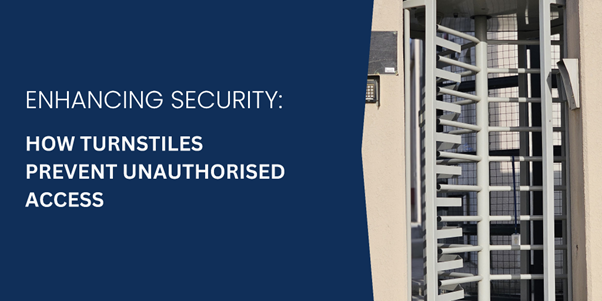
Enhancing Security: How Turnstiles Prevent Unauthorised Access
In an age when security is important, ensuring controlled access to sensitive areas is necessary. Turnstiles, a common feature in security infrastructure, have proven to be an effective barrier to unauthorised entry. Their strategic deployment in a variety of settings—from office buildings to stadiums and airports—demonstrates their adaptability and reliability. This blog explores the ways by which turnstiles improve security, including their one person at a time entry system, the need for authorised credentials, and real world examples showing their effectiveness.

Understanding Turnstiles
Turnstiles are safety barriers that control the flow of people by only allowing one person to pass at a time. They are frequently used alongside access control systems, which require users to use authorised credentials, such as key cards, biometric data, or tickets, to gain access.
The One Person at a Time System
The primary purpose of turnstiles is their ability to allow only one person to pass through at a time. This feature alone significantly boosts security by:
- Preventing Piggybacking: Piggybacking occurs when an unauthorised person follows closely behind an authorized user to gain access. Turnstiles mitigate this risk by physically blocking additional individuals from passing once the first person has entered.
- Controlled Entry: The one person at a time system ensures a controlled and orderly entry process, preventing rushes or crowding that could lead to security breaches or accidents.
- Accurate Counting: Turnstiles provide an accurate count of individuals entering and exiting a facility, which is vital for maintaining security and managing occupancy levels.
The Role of Authorized Credentials
Turnstiles commonly integrate with access control systems, requiring users to present authorised credentials before entering. These credentials can take the following types:
- Key Cards: Common in office buildings, key cards are swiped or tapped against a reader to gain access. Only those with valid credentials can unlock the turnstile.
- Biometric Data: More advanced systems use biometric data such as fingerprints, facial recognition, or iris scans to verify identity, adding a layer of security.
- Tickets: In environments like stadiums and transit stations, turnstiles may require the presentation of a valid entry ticket.
By requiring authorized credentials, turnstiles ensure that only individuals with permission can access certain areas, reducing the risk of unauthorised entry and enhancing overall security.
Real World Effectiveness of Turnstiles
Office Buildings
Turnstiles are commonly used in office buildings to secure lobbies and limit access to authorised visitors and employees. A turnstile supplier may offer a range of solutions suited to the specific requirements of corporate clients. For example, integrating with a building’s existing security system enables smooth access control, allowing employees to enter the building using their ID cards or biometric data.
Stadiums
Stadiums, with their large crowds and heightened security requirements, benefit immensely from the use of turnstiles. These devices help manage the flow of thousands of spectators, ensuring that only those with valid tickets gain entry. By preventing ticket fraud and controlling access, it enhances the overall security of the venue.
Airports
Airports are another environment where turnstiles play a crucial role. Security checkpoints and restricted areas within airports require stringent access control and provide a reliable solution. They ensure that only passengers with valid boarding passes and authorized personnel can access secure areas, thereby enhancing airport security.
Advantages of Turnstiles Over Other Security Measures
While there are various security measures available, turnstiles offer several distinct advantages:
- Physical Barrier: Unlike security cameras or alarms, turnstiles provide a physical barrier that prevents unauthorised entry in real time.
- Deterrence: The presence of turnstiles can act as a deterrent to potential intruders, as they signify a higher level of security.
- Integration: Easily integrated with existing security systems, enhancing their effectiveness without requiring a complete overhaul of current infrastructure.
- Cost-Effectiveness: Over time, turnstiles can be a cost-effective solution by reducing the need for extensive security personnel and minimizing losses due to unauthorised access.
Choosing the Right Turnstile Supplier
Selecting a reliable turnstile supplier is essential for ensuring the effectiveness of your security system. When evaluating suppliers, consider the following factors:
- Experience and Reputation: Choose a supplier with a proven track record and positive customer reviews.
- Customization Options: Look for a supplier that offers customizable solutions tailored to your specific security needs.
- Integration Capabilities: Ensure they can seamlessly integrate with your existing access control and security systems.
- Support and Maintenance: Opt for a supplier that provides ongoing support and maintenance services to keep your turnstiles functioning optimally.
By partnering with a reputable turnstile supplier, you can enhance your security infrastructure and ensure reliable access control.
Conclusion
Turnstiles are a crucial part of modern security systems, providing efficient and reliable access control in a variety of conditions. Their one person at a time entry mechanism, combined with the requirement for authorised credentials, significantly reduces the risk of unauthorised access. Turnstiles have proven effective in improving security and managing crowd flow in a variety of applications including office buildings, stadiums, and airports. By choosing the right turnstile supplier, you can implement an effective security solution that is customised to your specific requirements, resulting in improved safety for everyone.
Investing in turnstile is a proactive step towards improving your security, preventing unauthorised access, and keeping a safe and organised environment.